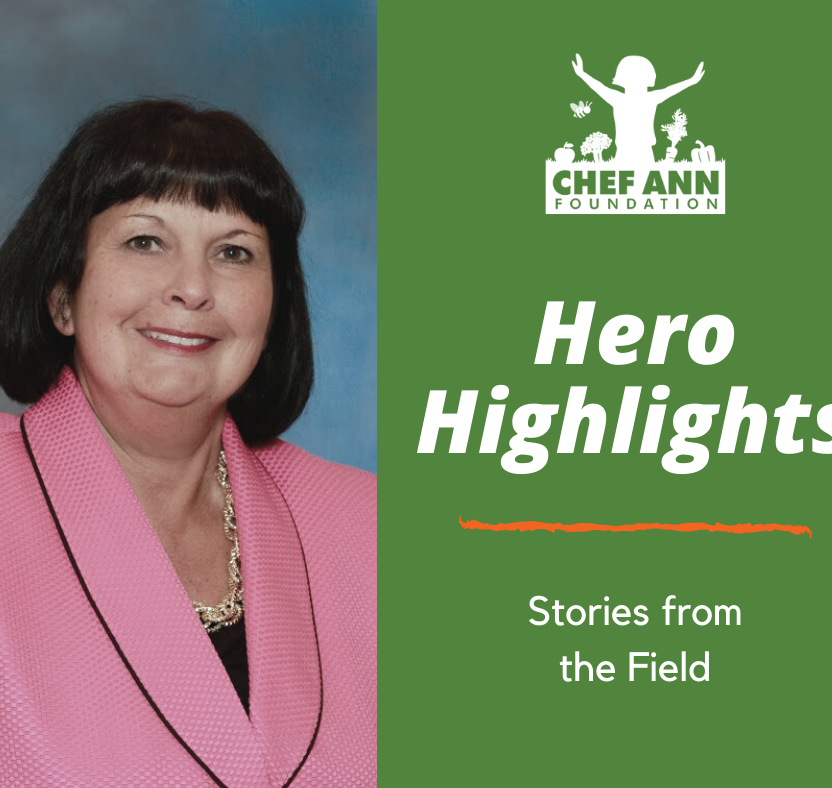
What It’s Like to be a School Food Director During COVID-19
Lori Danella shares her experience on the front lines of emergency feeding during widespread school closures.
March 20, 2020 | By Messa
This blog post is part of a new series on The Lunch Line called Hero Highlights. The Chef Ann Foundation wants to ensure the incredible stories of our school food workers are being told. These Hero Highlights are stories from the field during this challenging time, as school food teams tackle food insecurity due to widespread school closures amid the COVID-19 pandemic. Stay tuned for more.
For school food support during the coronavirus pandemic, view our COVID-19 Resources & Support page.
One thing is for sure: Lori Danella will do whatever it takes to keep her community fed. We had a chance to catch up with Lori, Food Service Director at Lee’s Summit R7 School District in Kansas City, Missouri, during a time when feelings of anxiety and stress are running high. Lori is on the front lines of emergency feeding at her school district, guiding her team with grace and compassion, and seeing success through her programming.
In Lee’s Summit, schools are currently on spring break. Earlier this week, they received word that schools would not resume session until April 3rd, with the possibility of an extension. This means that come Monday, March 23rd, her feeding plan will be in full swing. She opened a window for us into the critical planning phase when operating through this once-in-a-lifetime crisis, and shared some of her biggest challenges and successes so far.
Lee’s Summit R7 has a total of 24 schools dispersed through the district. Their enrollment is just over 18,000 with a 21% Free and Reduced Lunch Rate and has over 50% Average Daily Participation in their meal program.
When you first heard the news that COVID-19 might affect your district, what did you do?
First, I created a new standard operating procedure for the HACCP (Hazard Analysis and Critical Control Point) manual. I am using time as a control so anything that is perishable, like extra milk, will not go back in stock after the meals are served for the day. We are trying to limit food waste but will take extra precautions to uphold and maintain safety for our staff and students.
Are you still receiving your expected food deliveries?
I have been in contact with our supplier, US Foods, who will still be doing deliveries as usual. We will be sticking to our forecasted menu plans; at this time it is difficult to acquire items we have not already forecasted with the distributor due to increased demand nationwide. Our dairy supplier let us know there is no shortage, and they will be able to supply any amount we need. I think it’s very important that our students will still receive milk for both breakfasts and lunches.
How are you prioritizing which foods to serve?
Well, we are fortunate to have a warehouse with an up-to-date inventory. Each individual school also has up-to-date stock levels. I will be prioritizing the most shelf-stable items we have [for folks to take home], which is a considerable amount. We are anticipating serving over 1,000 breakfasts and lunches per day.
How will this differ from your typical meal program?
We usually have five hot lunch options per day. In this case, we will only have one option. There is such high demand, we need to create an effective system for assembly. Breakfasts will be packed in brown bags and lunches are in clear plastic bags. Both will meet all the meal components set by the USDA. We are also going to do some experimenting during this time. Our kids love breakfast burritos so we will try to have heated breakfast burritos one day, stored in separate coolers. When students pull up, we will add in the breakfast burritos and hand them over. We will be communicating that all meals are for immediate consumption off-site. Everyone who comes to a site will receive a meal, regardless of if they qualify for free and reduced lunches.
How did you choose which school sites to serve, and how will you serve the meals?
It has taken quite a bit of work, to be honest with you. Three of our schools have over 50% of students that qualify for Free and Reduced lunches, but those families also have limited transportation, so those schools were our first choice. We then spread out the remaining sites to encompass as much of our population as we could and our serving area is still growing. We will be putting the meals together at one of our high schools using our food service staff and will be relying on transportation staff to drive the buses. The buses will pick the meals up along with 2 of our staff to distribute the meals at our planned stops. We will have five buses going to two school locations for each meal. These buses will also make stops at large apartment complexes and townhouses. Our district has dispersed poverty and we need to make sure we are serving our entire community, especially those without income right now.
How is your staff handling this? Are you using any special protocols?
Our staff is in it; all we are hearing is “What can we do to help?” and “When do we get to work?” I am doing my best to take into account everyone’s needs. We are all listening to each other and working together. We are following all of our usual standard operating procedures - we have a perfect health inspection record. We truly live and breathe food and health safety. Out in the community, my staff will be wearing masks and we will be trying to limit congregating at the feeding sites. Meals will be picked up by families so there is no hand to hand contact. There will be gloves and sanitizer supplies on each bus so my staff can be changing gloves after each family they interact with. We have had overwhelming support from the community wanting to help, and we are working on a plan to properly train any volunteers on sanitation and safety.
What have been some of your biggest successes?
This has to be the most stressful situation I have ever endured due to the unknowns. My biggest success has been pulling this plan together in less than a week. So many families and students rely on us for food, and we are going to do whatever it takes to get them fed. We have been able to work closely with our Mckenny-Vento and Head Start programs as well—no student has been overlooked. I am thankful for the incredible support we have from the School Nutrition Association and my fellow Food Service Directors. This is a once in a lifetime situation, and we need to continue to stay flexible.
For school food support during the coronavirus pandemic, view our COVID-19 Resources & Support page.






